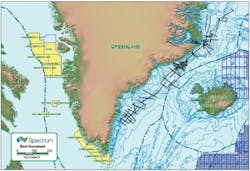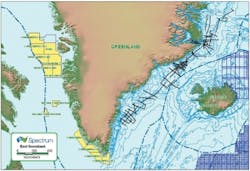Demand surging for ultra-deepwater rigs
Bruce Beaubouef • Houston
Seadrill says tendering and contracting for ultra-deepwater rigs worldwide has improved significantly this year. Available rig capacity has also been absorbed rapidly.
Despite the fall-out from the Macondo incident last year, the company says utilization rate in the ultra-deepwater market (up to 7,500 ft, or 2,286 m water depth) has remained nearly 100%.
In the US Gulf of Mexico, increased clarity concerning new drilling permit requirements has led to renewed interest in securing rig capacity. Seadrill expects this positive trend to continue.
The company also has noticed a surge in ultra-deepwater rig demand in West Africa, Southeast Asia, and Brazil. As a result, available rig capacity has diminished rapidly. The market appears to be close to a supply/demand balance, and based on known programs, the number of available rig years in 2011 could drop to less than two rig years and then to less than 10 rig years in 2012.
Over the longer term, Seadrill adds, the increase in rigs under construction could restrain the upside potential of day rates from late 2013 and into 2014. Since last November, it adds, the number of new ultra-deepwater rigs on order has risen to 31.
Nevertheless, two recent five-year contracts awarded for the Gulf of Mexico with start-up in late 2013 underline the importance of new and modern equipment and on the sound environment for ultra-deepwater field developments.
Consensus is growing, Seadrill concludes, that the number of drilling programs planned to start prior to end-2012 exceeds the number of rigs available and technically capable of such work.
Seadrill also sees steady improvement in demand for premium jackups suited for water depths to 350 m (1,148 ft). Oil companies are drawn to the safety and efficiency gains offered by the newer, higher-spec units.
Despite the 40 new jackups ordered since last October, utilization worldwide of premium jackups has remained above 90%. The general preference is for new rigs at the expense of older rigs, even when the drilling program does not demand these increased technical capabilities, says Seadrill.
Southeast Asia is the biggest draw for premium jackups, but there has been increased interest from the Middle East, West Africa, and the Americas.
In the North Sea, oil companies have been looking for very large, high-spec harsh environment jackups that can drill and simultaneously host production equipment.
This trend has led to the order of various new rigs, some with long-term contracts but most ordered on speculation.
Rowan contracts to build two 12,000 ft drillships
Rowan Companies has announced that a subsidiary has entered into turnkey contracts for the construction of two ultra-deepwater drillships with a cost of approximately $605 million each. The drillships will be constructed by Hyundai Heavy Industries Co. at its Ulsan shipyard, and are expected to be delivered in late 2013 and mid-2014.
The DP-3 compliant, dynamically positioned drillships will be equipped with retractable thrusters, dual-activity capability, five mud pumps, dual mud systems, and a maximum hook-load capacity of 1,250 tons. Each will be equipped with a seven-ram BOP incorporating full acoustic backup control, and storage and handling facilities for a second BOP. The drillships feature hull integration with below-deck riser storage, 4 million pounds riser tensioning, main load path active-heave drawworks with crown-mounted compensation, three 100-ton knuckle boom cranes, an active-heave 165-ton crane for simultaneous deployment of subsea equipment, a variable deck load capacity of 20,000 tons, and accommodations for 210 personnel.
Gibdock wins further commission from Solstad
Solstad Offshore has commissioned Gibdock to drydock and to convert the platform support vesselNormand Vester. Last year, the yard converted the Normand Trym and Normand Vibran for the same owner.
The scope for this latest project is similar, with some differences. For instance, theNormand Vester's fresh water capacity is being increased by converting two of the stability tanks from water ballast to fresh water, and eight of its mud tanks are being converted to provide increased fuel storage.
Solstad Offshore has commissioned Gibdock to drydock and to convert the platform support vesselNormand Vester. This work is needed to prepare the 84-m (275-ft) long, 4,500 dwt vessel for a four-year charter that Solstad has recently agreed to with Petrobras offshore Brazil.
Additionally, two wing tanks are being converted to void spaces opened by the changes to the stability tanks. This work is needed to prepare the 84-m (275-ft) long, 4,500 dwt vessel for a four-year charter that Solstad has recently agreed to with Petrobras offshore Brazil. Here the vessel will need to supply offshore facilities with 1,600 cu m (422,675 gal.) of potable water and 1,600 cu m of fuel oil.
Another Solstad ship, the 127-m (416-ft) long, 9,500 dwt construction vesselNormand Cutter, also docked at Gibdock in April following a program off West Africa, to undergo its second class renewal. Gibdock also conducted thruster, crane, and general repair work.
Petrobras releases drilling rig contract bidding process
Petrobras has approved the bidding process to award contracts for multiple offshore drilling rigs to be built in Brazil. Each rig will get a leasing contract with the successful bidder and an operation service contract. Companies can bid for one or more rigs up to a total of 21 units. Certification of minimum domestic content is required. Petrobras says this is part of its plan to contract as many as 28 new ultra-deepwater drilling rigs for, among other things, pre-salt field exploration. A contract for the first batch of seven rigs was announced this February by Petrobras.
Offshore Articles Archives
View Oil and Gas Articles on PennEnergy.com


